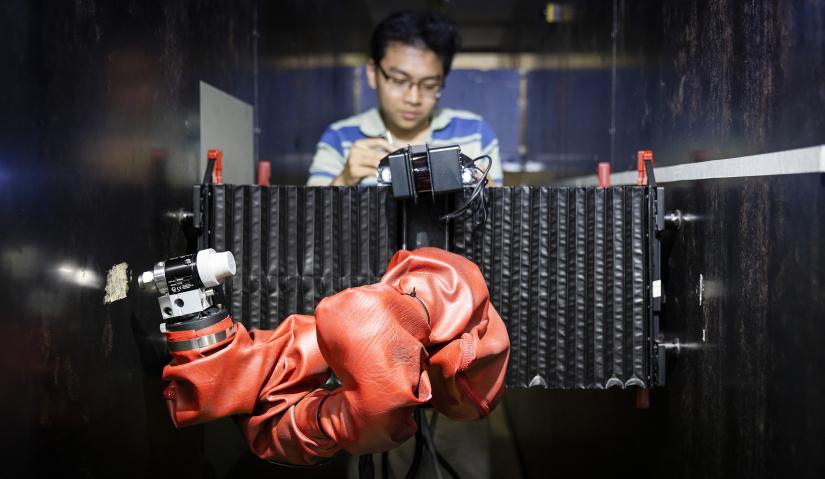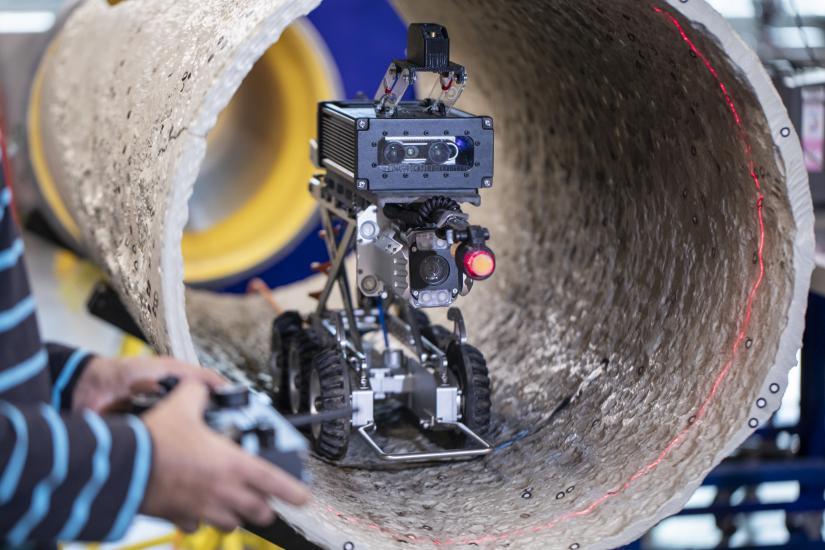Growing pressure on assets due to population growth and tighter work place health and safety requirements, means asset owners are required to do more with less. The UTS Robotics Institute specialise in developing intelligent robotic systems to monitor and maintain infrastructure in transport, water and energy in a safer and more cost-effective way.

Director of Robotics in Infrastructure: Associate Professor Jaime Valls Miro
Showcase under the robotics in infrastructure nodes:
Intelligent robots for bridge maintenance
Research Lead/s :
Distinguished Professor Dikai Liu
Maintaining the Sydney Harbour Bridge, in particular, the internal surface of the narrow arch tunnels with a total length of 7.2km, is an ongoing challenge as it may expose bridge workers to many hazards such as lead based paint, confined spaces, dust and working at heights.
With increasingly stringent health and safety regulations, there is a crucial need for innovative intelligent robots to address these significant health and safety issues. Researchers at the Robotics Institute have been collaborating with the Roads and Maritime Service of NSW since 2006 to conduct robotics research, develop enabling methodologies, and develop various autonomous robots for steel bridge maintenance.
Part of the outcomes of this collaboration are the world’s first of their kind intelligent robots, including :
- Autonomous grit-blasting robots for surface cleaning,
- Bio-inspired climbing robot (CROC) for inspecting internal surfaces of the narrow arch tunnels, and
- Autonomous robots (WAuMBot) for cleaning and painting the internal surfaces.
These robots have the ability to autonomously conduct exploration, 3D map building, collision avoidance, path/motion planning and maintenance operations. The WAuMBot can also navigate through rivet filled tunnels with manholes and partition plates by using its four expandable legs and toes.
Research Stength/s : Sensing, perception and estimation, Control, planning and coordination, Platforms
Research Partner/s : RMS (Road and Maritime Services)
Condition assessment of critical water mains
Research Lead/s :
A/Prof. Jaime Valls Miro,
Dr. Ravindra Ranasinghe,
Emeritus Prof. Gamini Dissanayake
Sydney Water manages a complex water network that includes 5,000 km of large-diameter critical pipelines.
To maintain customer satisfaction and minimise loss of water it is essential to manage leaks and break through implementing an effective and efficient preventive maintenance and renewal program, Sydney Water in collaboration with Robotics Institute at University of Technology Sydney (UTS:RI) has developed two world-leading robotic condition assessment tools.
In the short interval between a break and its repair, or during a planned shutdown, these robots can travel inside a water main and provide measurements of the extent of corrosion of the pipe wall. Sydney Water has an on-going program for using these tools in collaboration with UTS and has successfully deployed them on twenty two occasions to date.
See more via UTS RI YouTube -
Inspection robot of large CI critical water mains
R2T2 - A Rapid Response Pipe Inspection Robot
Research Stength/s : Sensing, perception and estimation, Control, planning and coordination, Platforms
Research Partner/s : Sydney Water
Condition assessment of sewer rising mains
Research Lead/s :
A/Prof. Jaime Valls Miro,
Emeritus Prof. Gamini Dissanayake,
Dr. Ravindra Ranasinghe
Collaboration between SWC and UTS over the period 2017-2019 has resulted in two water mains wall inspection robots which are being successfully deployed in SWC water mains network, providing valuable non-destructive condition assessment for SWC maintenance and renewal program. These robots are not suitable for deployment into Sewer Rising mains, and two new robots are to be designed with a specification requirement adapted to meet the needs of the Sewer Rising mains team at SWC, as outlined in this document. The robots have the capability to traverse and assess corrosion levels of the pipe walls and report the internal condition of the main. This information is relayed to an operator real-time and recorded for later review.
The first robot is designed leveraging the current proven robotic concept for water mains and target larger CI (CICL) rising mains, range 450mm-750mm. The second robotic tool will be designed to allow deployment onto the smaller range of 250-450mm rising mains. Subject to sensor performance, the pipe material sensed by the robot will also extend to DICL and MSCL.
See more via UTS RI YouTube -
Field deployment of RimaBot1 (Rising Mains robot)
Research Stength/s : Sensing, perception and estimation, Control, planning and coordination, Platforms
Research Partner/s : Sydney Water
Condition assessment of wastewater pipes
Research Lead/s :
Prof. Sarath Kodagoda
Corrosion of concrete sewers is a significant global problem, posing threats to utility operations, public health and the environment. Direct assessment of concrete corrosion is complex and difficult, as most pipes are underground and are too small to directly measure corrosion. In traversable sewer systems, the corroded parts need manual removal and in non-traversable sewers, utilities often use CCTV cameras, which only provide visual information as they cannot estimate the depth of corrosion. The consequence is that water utilities do not have comprehensive information to make timely and accurate decisions.
The iPipes Lab at UTS:RI collaborates with Sydney Water to develop innovative sensing and robotic solutions to non-destructively assess the condition of both traversable and non-traversable concrete sewerage pipes. This is achieved by a modular design of sensors which can be used as a handheld sensing suite and as robotic deployment. The tools are designed to be used by the water utilities to identify the areas that need rehabilitation.
The intelligent toolkits provide crucial data, informs timely decisions to save renewal costs, reduces impact to the environment and improves human health and safety. This breakthrough technology has won the prestigious 2020 National Research Innovation Award and 2020 New South Wales Research Innovation Award from the Australian Water Association. The robotic tools will transform the way the water utilities do condition assessment of their multi-billion-dollar assets.
See more via UTS RI YouTube -
Innovative sensor suites and intelligent robotics
Research Stength/s : Sensing, perception and Artificial Intelligent (AI)
Research Partner/s : Sydney Water
Condition assessment of liners and coatings
Research Lead/s :
Prof. Sarath Kodagoda
In December 2017, the CRC-p on ‘Smart Linings for Pipe and Infrastructure’ project received $3 million over three years in funding from the Commonwealth Government. The total project was valued at a total of over $24 million, with 34 partners and will strategically position Australia as a global leader in smart water infrastructure design, engineering, testing and management. The iPipes lab at UTSRI is playing a key role by developing smart sensing and robotic tools for quality assurance of water and sewer pipe linings in long-term and after lining applications.

The iPipes lab team uses ultrasound, pH and electrical resistivity based sensing technologies for quantifying defects in sewer pipe linings. Further, we deploy robots with laser sensing, profiling and ultrasound technologies to identify and quantify defects in water pipe linings. The information is to be fed back to lining applicators and water utilities, who use it to make decisions about fit for purpose renewal methods.
See more via UTS RI YouTube -
laser profiling of internal pipe surface
Research Stength/s : Sensing, perception and Artificial Intelligent (AI)
Research Partner/s : WSAA and 33 national/international partners
Condition assessment of towers
Research Lead/s :
Dist. Prof. Dikai Liu,
Emeritus Prof. Gamini Dissanayake,
A/Prof. Marc Carmichael
In collaboration with Tokyo Electric Power Company (TEPCO), Japan, UTS Robotics Institute has been developing an intelligent robot for cleaning, painting and inspection of electric power transmission towers. The robot is capable of:
(1) moving to a position in a transmission tower through the supporting structure;
(2) sensing and perception of the beam members around the robot;
(3) building 3D map of the beam members including nuts and bolts;
(4) planning trajectories for laser cleaning and painting;
(5) collecting surface information for inspection and quality assessment.
Research Stength/s : Sensing, perception and estimation, Control, planning and coordination, Platforms
Research Partner/s : Tokyo Electric Power Company (TEPCO), Japan
Underwater pylon inspection
Research Lead/s :
Dist. Prof. Dikai Liu,
Emeritus Prof. Gamini Dissanayake,
A/Prof. Shoudong Huang
The autonomous underwater maintenance robot is developed by the UTS Robotics Institute (UTS:RI) at UTS in partnership with the NSW Roads and Maritime Services (RMS). The robot provides an innovative and practical solution to keep workers safe during maintenance of underwater structures in shallow waters, which involves working in dangerous water currents, and high-pressure water-jet cleaning.
Key features of the autonomous underwater robots includes:
1) Multi-modal sensing to localize and reconstruct 3D map of underwater structure
2) Extensive environmental and operational awareness to - autonomously navigate around the structure, plan water-jetting trajectories for cleaning surfaces, and collecting image data of cleaned surfaces for inspection.
See more via UTS RI YouTube -
SPIR: Submersible Pile Inspection Robot
Research Stength/s : Sensing, perception and estimation, Control, planning and coordination, Platforms
Research Partner/s : RMS (Road and Maritime Services)

